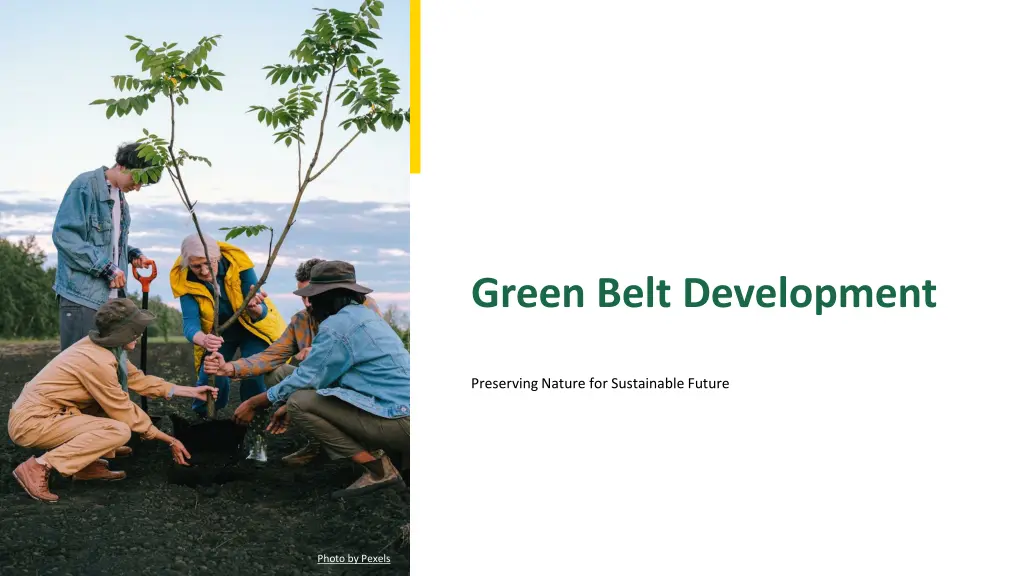
Green Belt Development for a Sustainable Future
Explore the concept, benefits, challenges, and global examples of green belt development in urban planning. Discover how green belts preserve nature, support biodiversity, and contribute to sustainable land use practices while enhancing the quality of urban environments.
Download Presentation

Please find below an Image/Link to download the presentation.
The content on the website is provided AS IS for your information and personal use only. It may not be sold, licensed, or shared on other websites without obtaining consent from the author. If you encounter any issues during the download, it is possible that the publisher has removed the file from their server.
You are allowed to download the files provided on this website for personal or commercial use, subject to the condition that they are used lawfully. All files are the property of their respective owners.
The content on the website is provided AS IS for your information and personal use only. It may not be sold, licensed, or shared on other websites without obtaining consent from the author.
E N D
Presentation Transcript
Green Belt Development Preserving Nature for Sustainable Future Photo by Pexels
01 The Concept of Green Belt Table of Contents 02 Benefits of Green Belt 03 Challenges in Green Belt Development 04 Global Examples of Green Belt Success 05 Urban Planning Integration with Green Belts 06 Future Prospects for Green Belt Development
1 The Concept of Green Belt Land Preservation Green belt policy aims to protect undeveloped, wild, or agricultural areas in urban planning to maintain environmental balance and biodiversity. Preserving green belts contributes to reducing urban sprawl, ensuring green spaces for recreation, and safeguarding natural habitats and ecosystems. Green belts play a vital role in enhancing air quality, mitigating climate change, and providing a sense of well-being to urban residents and wildlife. Designating and enforcing green belt areas require collaboration between policymakers, environmentalists, and Photo by Pexels communities for sustainable land-use planning.
2 Benefits of Green Belt Environmental Impact Green belts promote ecological balance, support wildlife habitats, and protect endangered species from habitat destruction due to urbanization. Preserving green belts helps in conserving biodiversity, enhancing water quality, and reducing soil erosion and flood risks in urbanized regions. The presence of green belts improves the aesthetic appeal of cities, reduces noise pollution, and provides recreational spaces for residents to enjoy nature and outdoor activities. Effective management and maintenance of green belts are essential to ensure their long-term sustainability and Photo by Pexels maximize their environmentaland social benefits.
3 Challenges in Green Belt Development Sustainable Management Balancing economic development with green belt preservation poses challenges such as conflicting land-use demands, limited resources for conservation, and pressure for urbanexpansion. Ensuring public awareness and participation in green belt initiatives, enforcing land-use regulations, and addressing illegal encroachments are key challenges in maintaining green spaces. Managing invasive species, preventing pollution, and addressing climate change impacts are critical for preserving the integrity and functionalityof green belt areas. Photo by Pexels Sustainable funding, political commitment, and community
4 Global Examples of Green Belt Success Inspirational Models Cities like London, Tokyo, and Vienna have successfully implemented green belt policies to preserve natural areas, enhance urban livability, and promote sustainable growth and environmental conservation. The Greenbelt Act in Ontario, Canada, and the Protected Green Belt Areas in China are examples of legislative measures that support the conservation of green spaces and sustainable land use. International initiatives like the Great Green Wall in Africa and the Belt and Road Green Development Partnership demonstrate collaborative efforts to combat desertification, Photo by Pexels promote afforestation, and restore degraded landscapes.
5 Urban Planning Integration with Green Belts Smart Development Integrating green belt planning with urban development strategies enhances city resilience, promotes sustainable transportation options, and creates green corridors for wildlife migration and biodiversity conservation. The incorporation of green infrastructure in urban planning, such as green roofs, rain gardens, and permeable pavements, improves stormwater management, reduces urban heat island effect, and enhances urbanaesthetics. Green belts provide opportunities for urban agriculture, community gardens, and green businesses, contributing to local food production, economic development, and social Photo by Pexels cohesion in urbanareas.
6 Future Prospects for Green Belt Development Sustainability Goals The integration of green belt development into national policies, urban master plans, and environmental strategies is essential for achieving sustainable development goals and combating the impacts of rapid urbanization. Adopting innovative approaches, such as green infrastructure financing mechanisms, nature-based solutions, and green technology applications, can enhance the effectiveness and resilience of green belt projects in the face of climate change and urbanchallenges. Engaging stakeholders, fostering partnerships, and leveraging community support are key strategies for scaling up green Photo by Pexels belt initiatives, fostering green entrepreneurship, and
